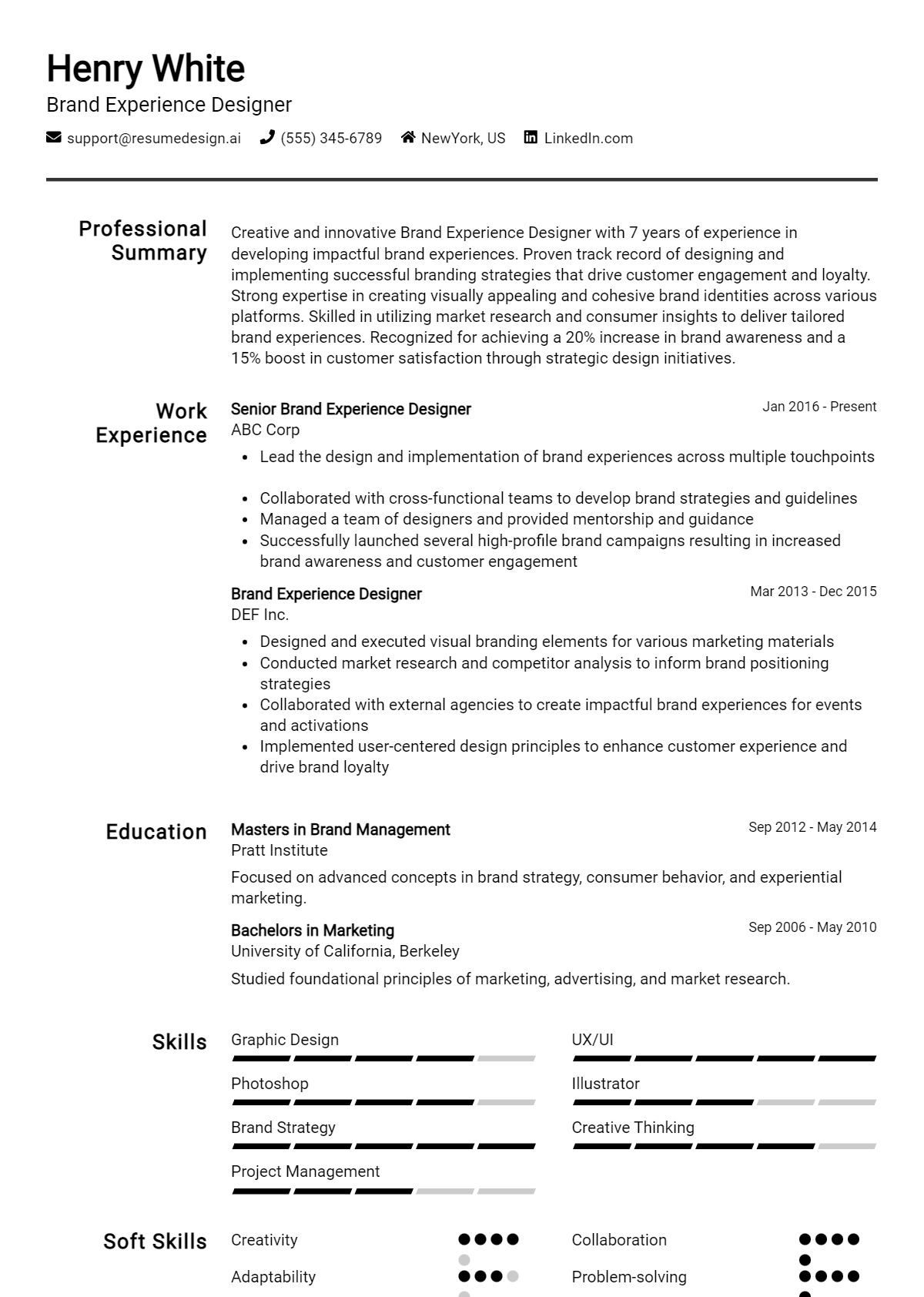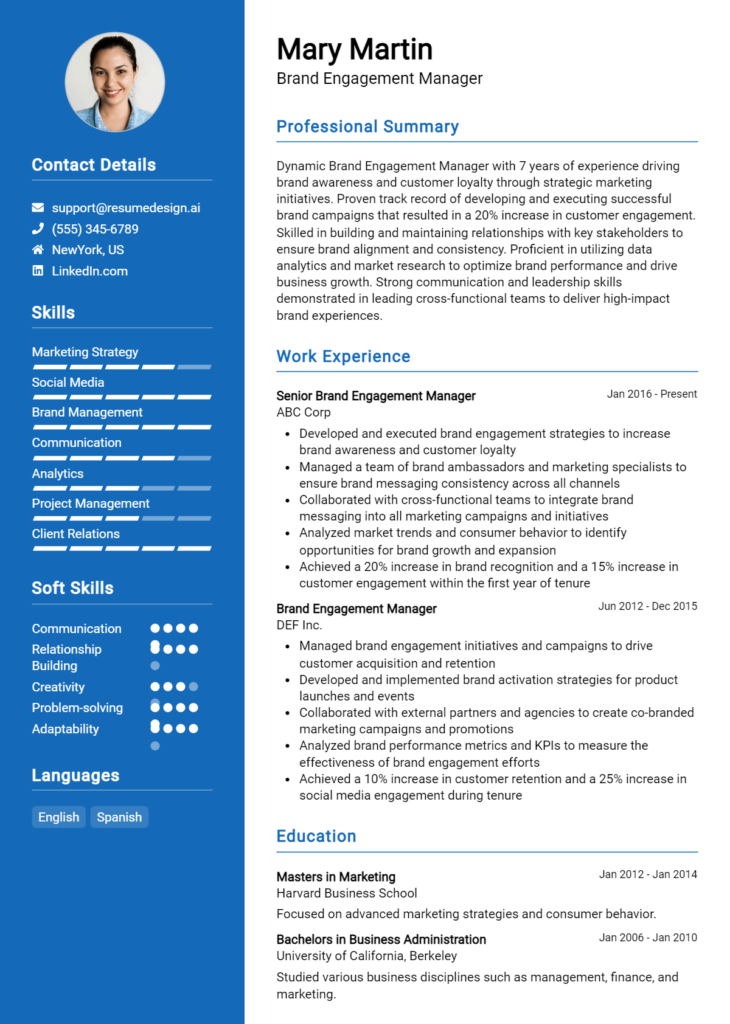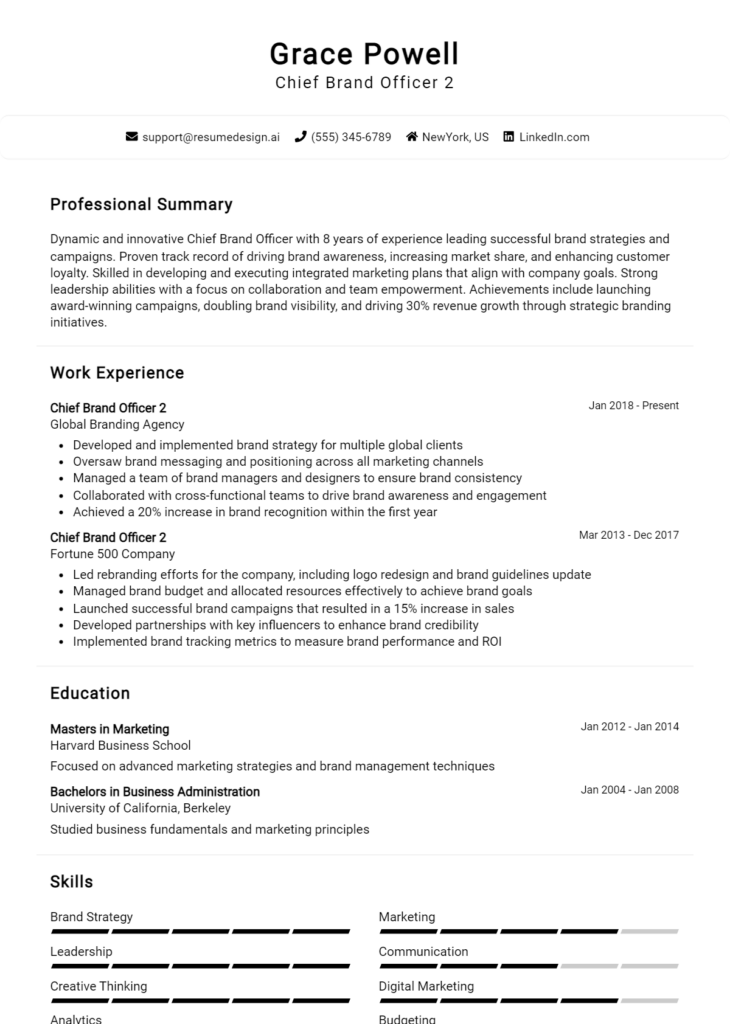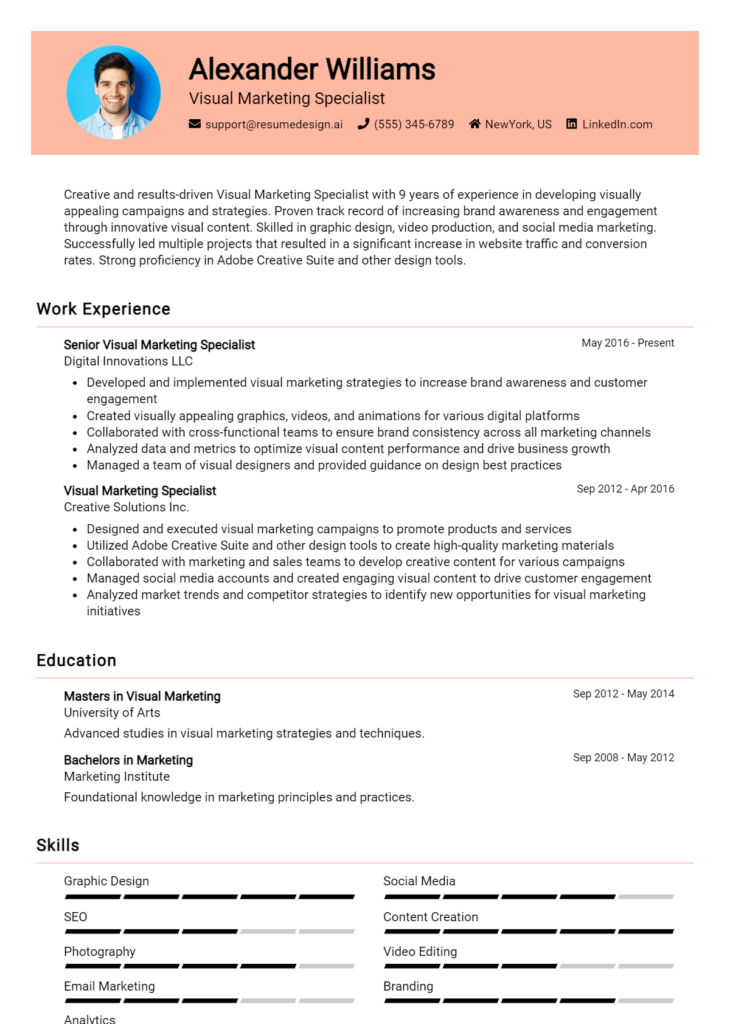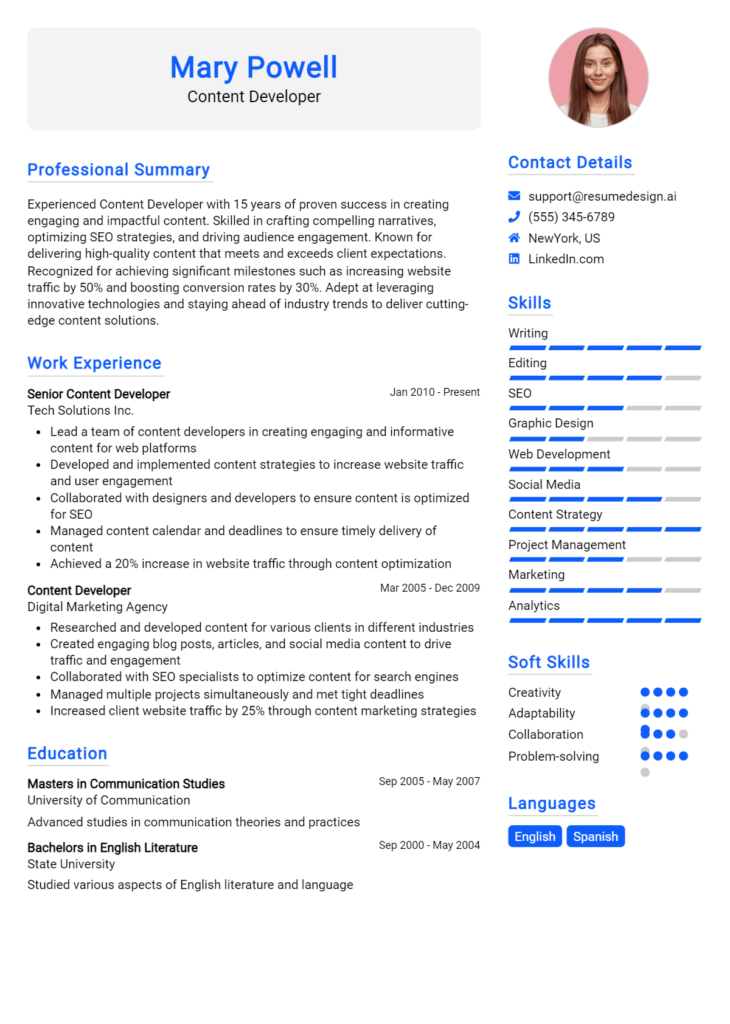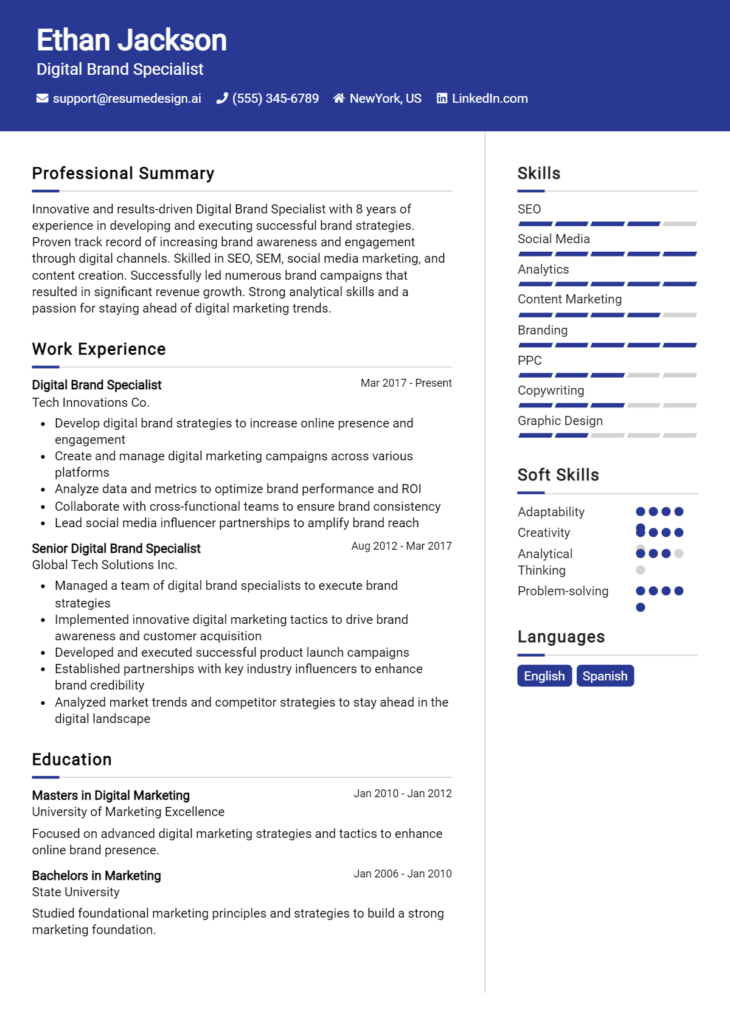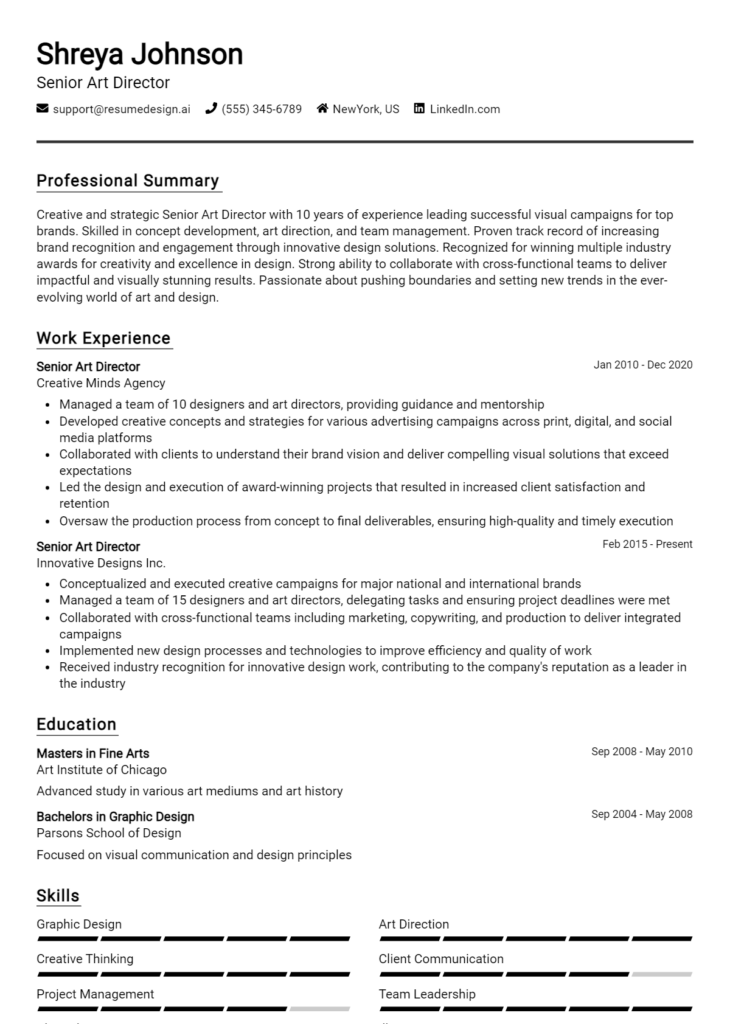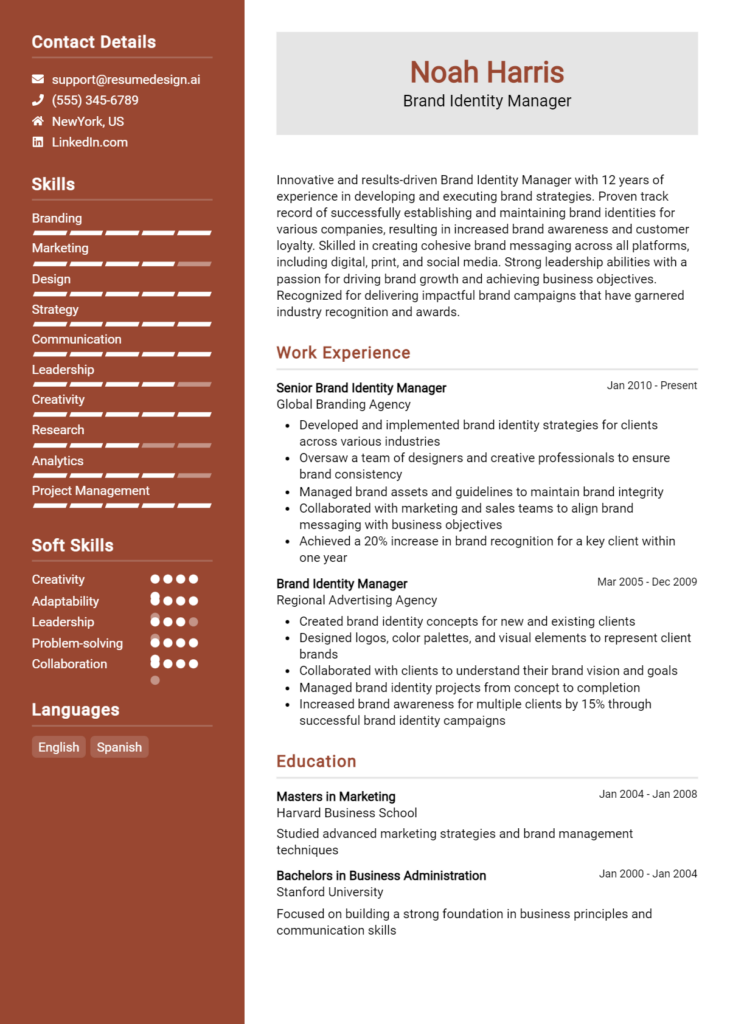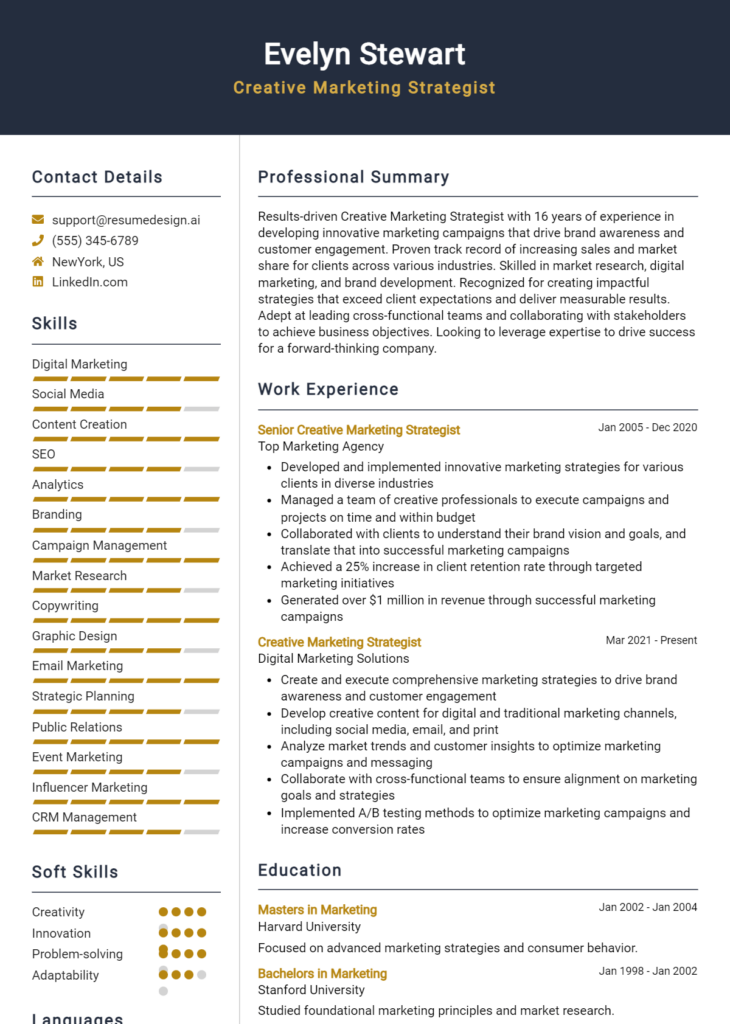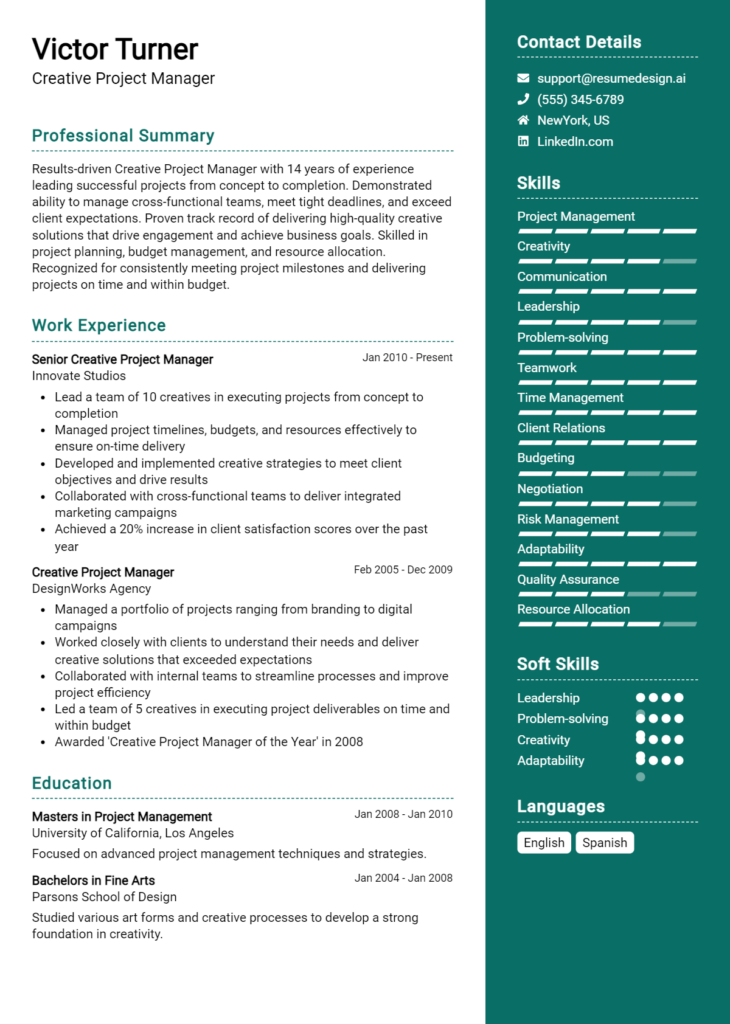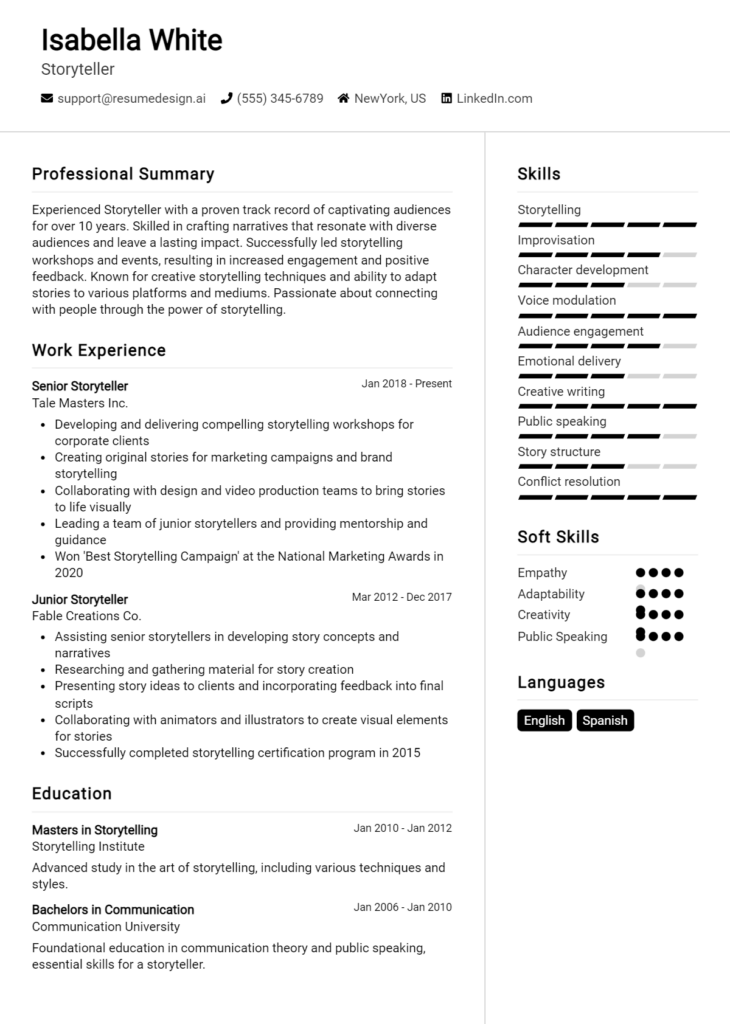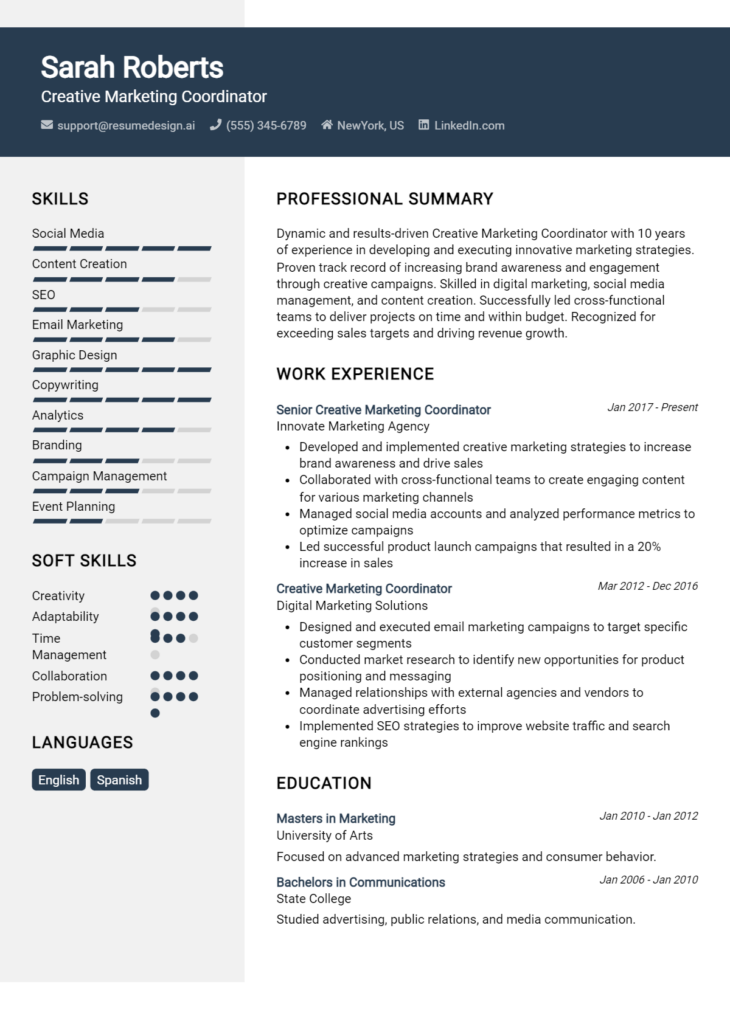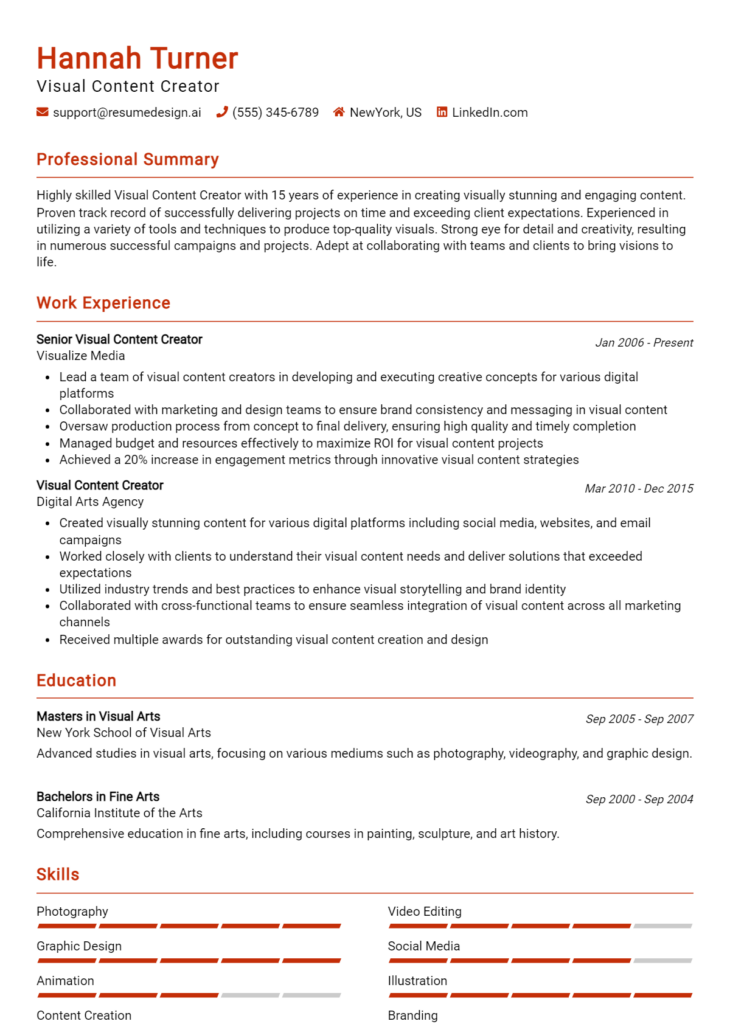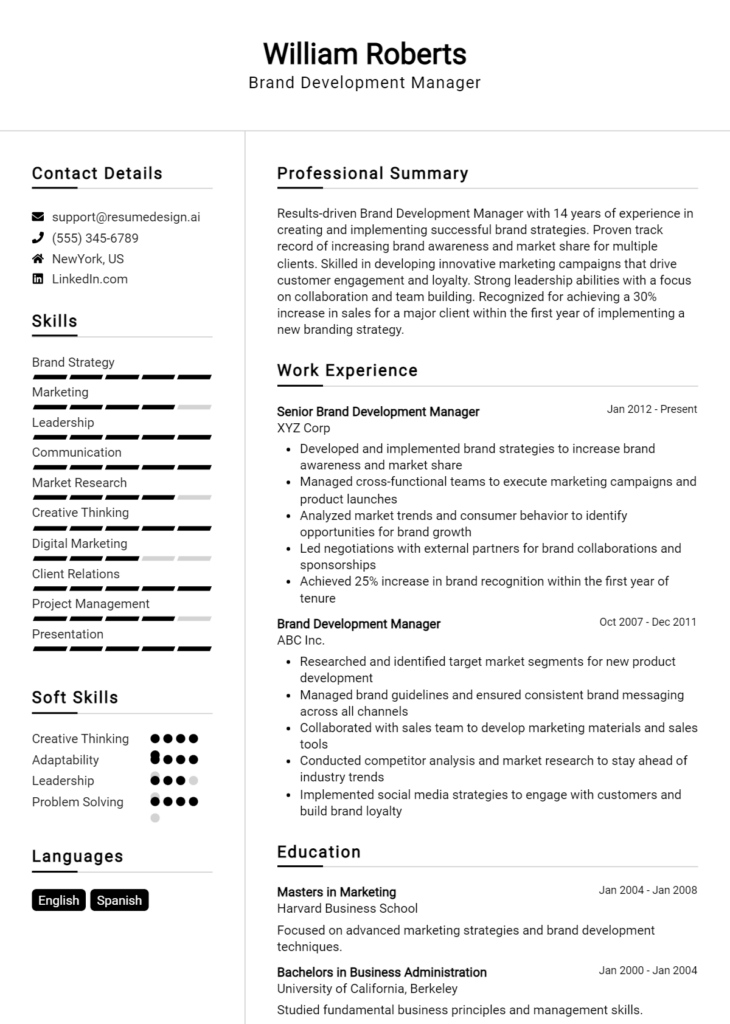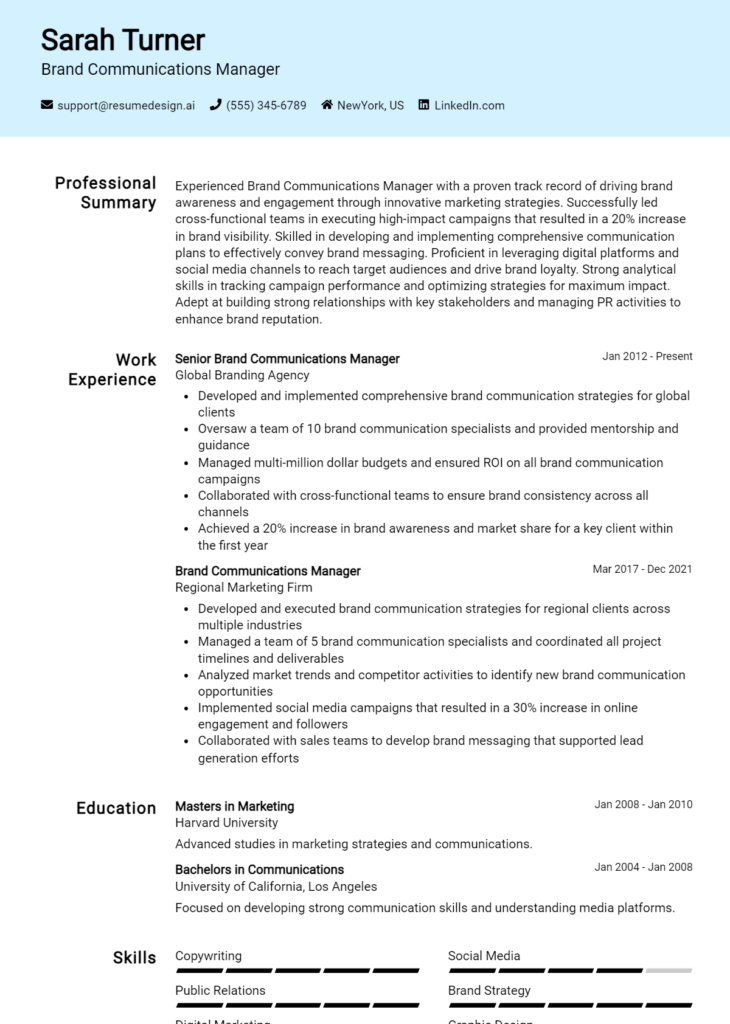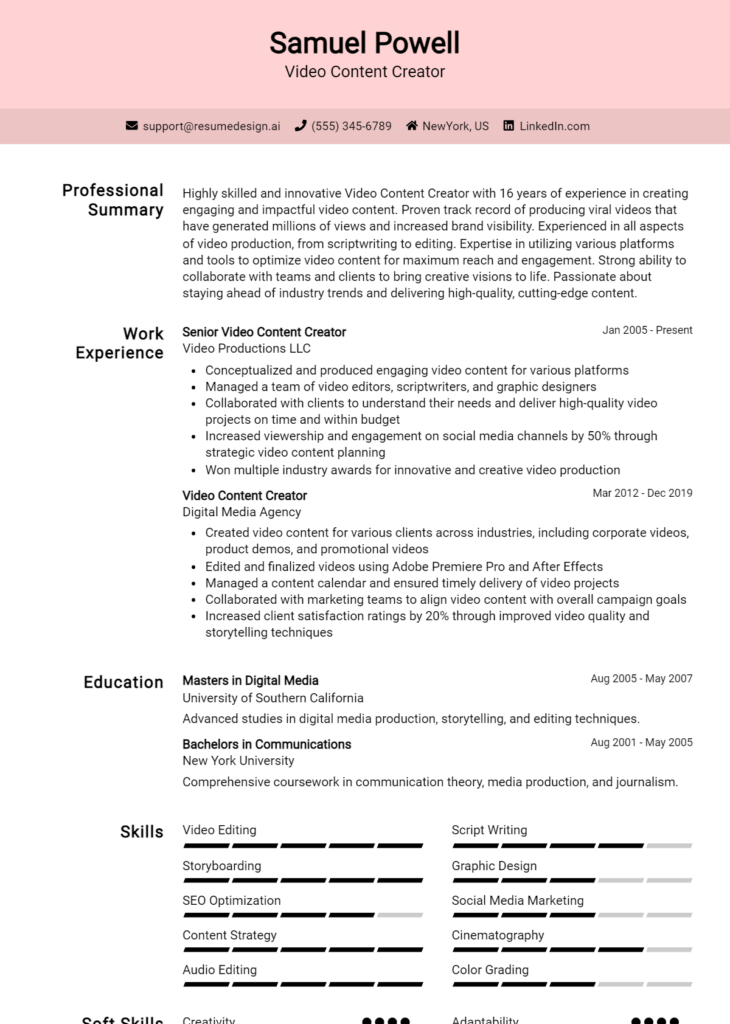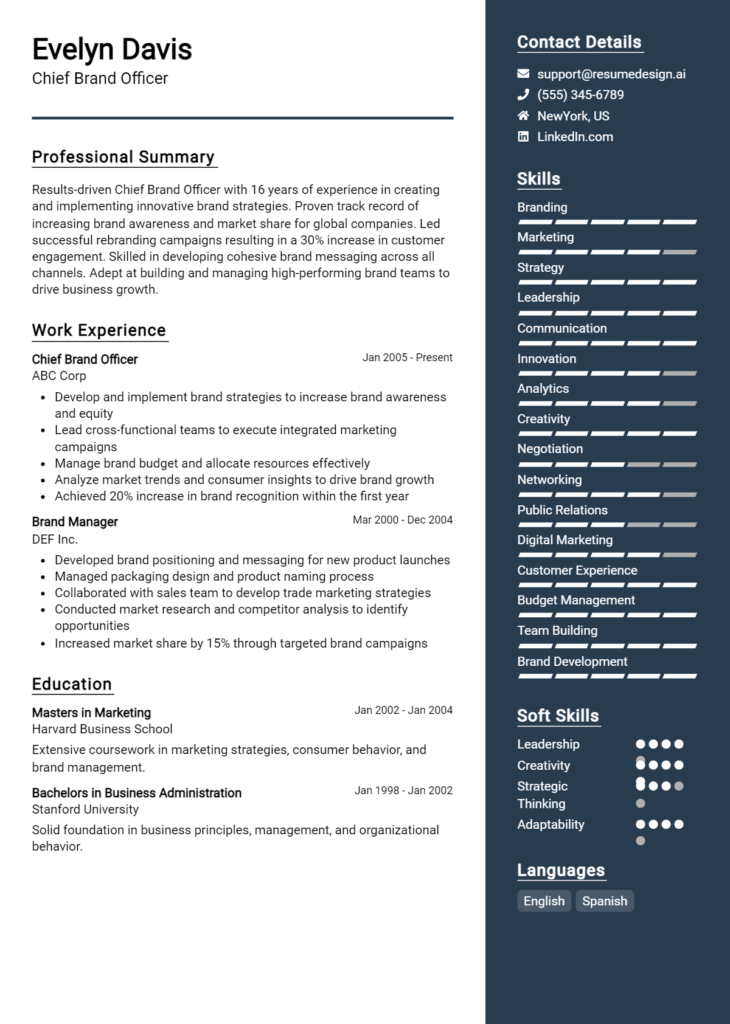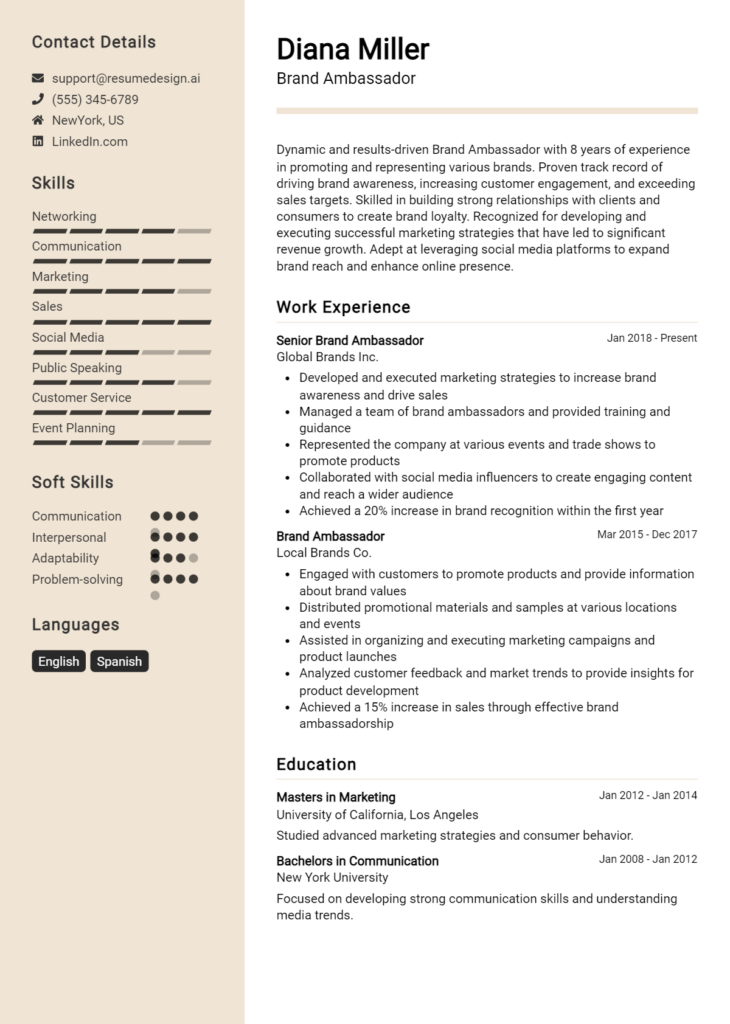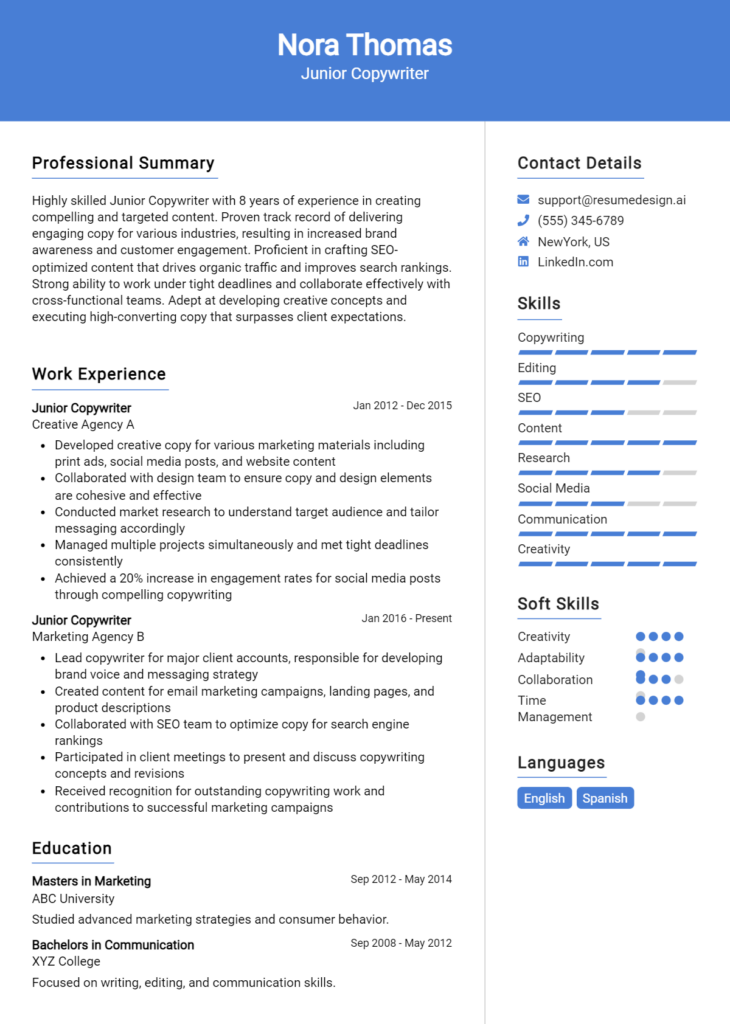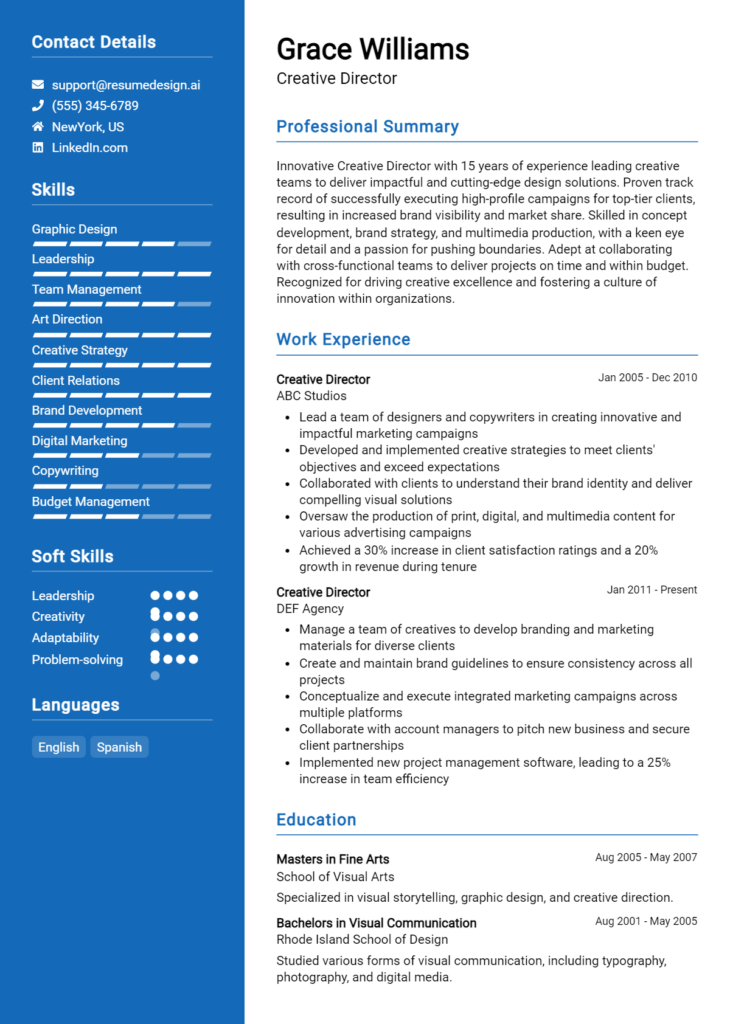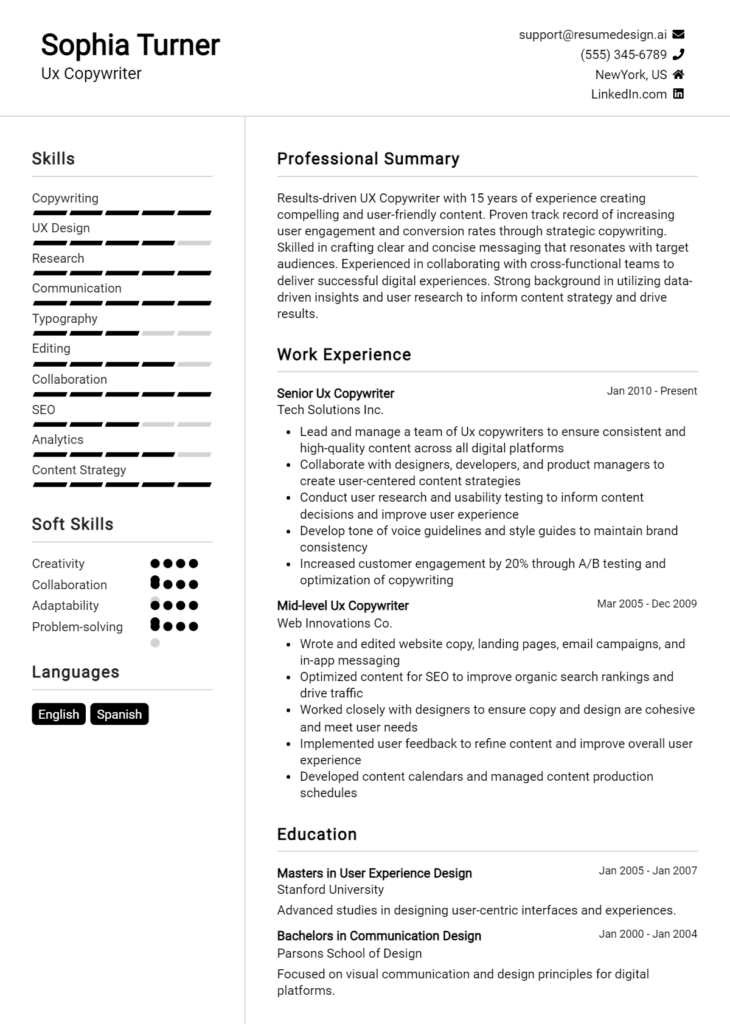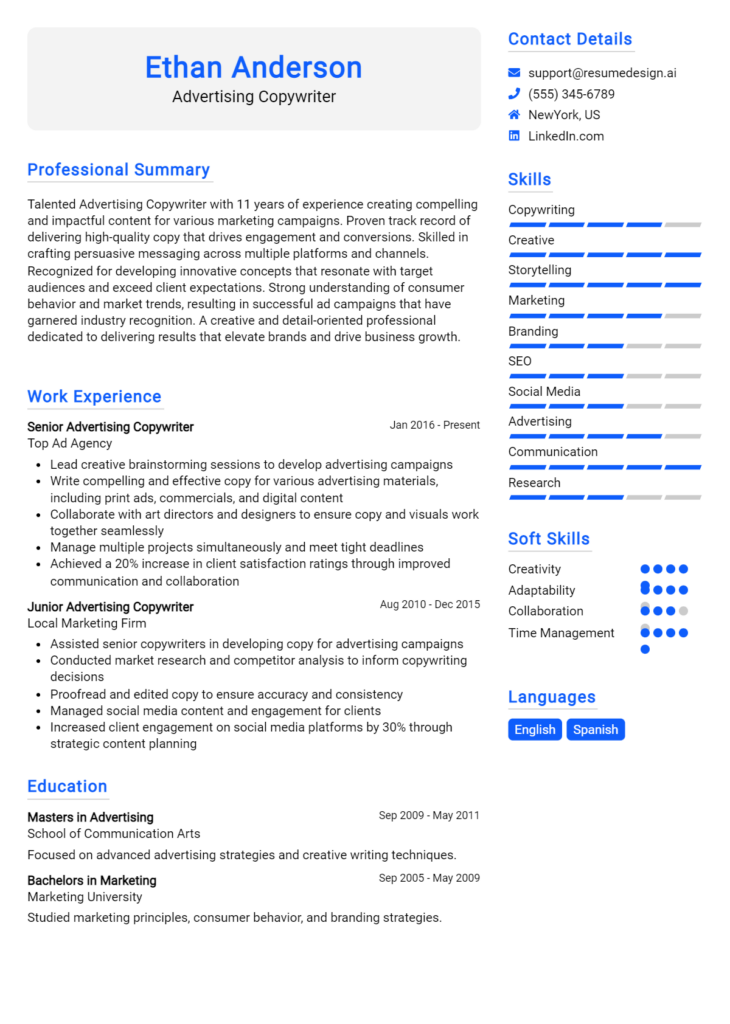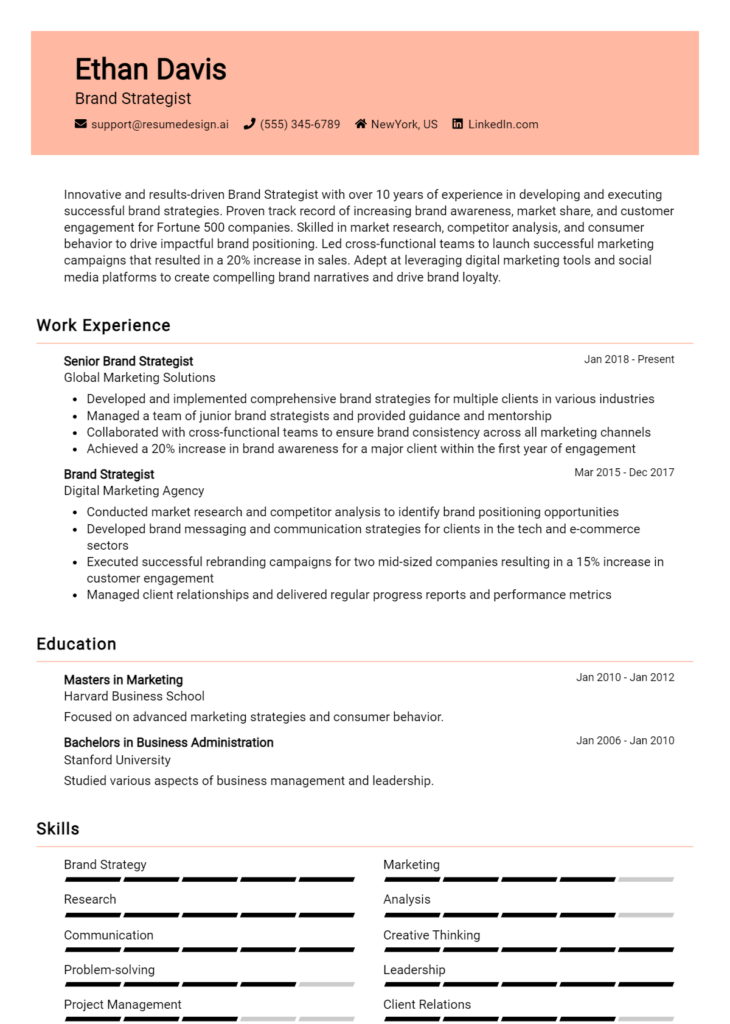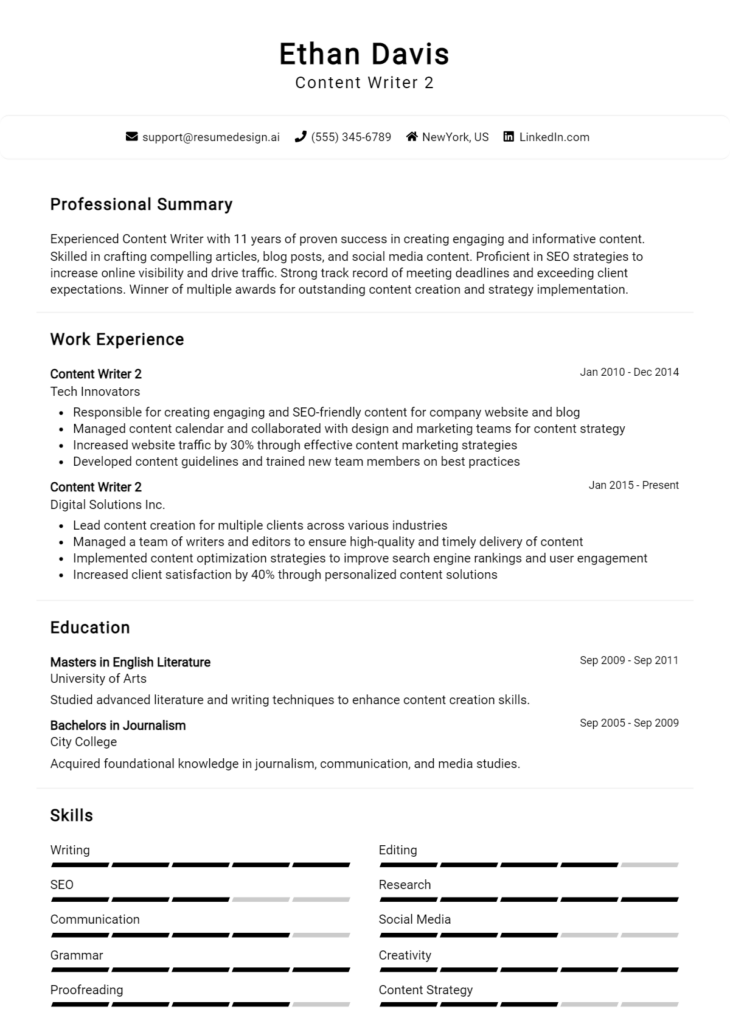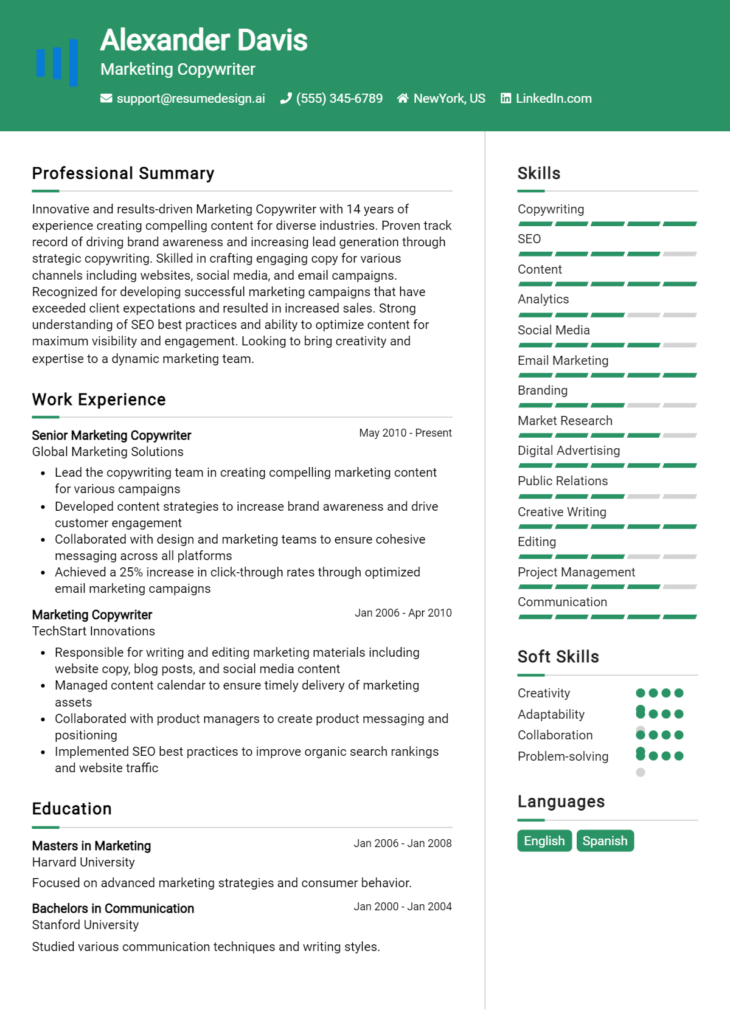Brand Experience Designer Core Responsibilities
A Brand Experience Designer is responsible for creating cohesive and engaging brand narratives across various touchpoints. This role bridges marketing, design, and product development teams to ensure a unified brand experience. Key skills include technical proficiency in design software, operational insight into project management, and strong problem-solving abilities to tackle brand challenges. These skills are essential for aligning brand strategies with organizational goals. A well-structured resume highlighting these qualifications can significantly enhance job prospects.
Common Responsibilities Listed on Brand Experience Designer Resume
- Developing and executing brand strategies and guidelines.
- Collaborating with cross-functional teams to ensure brand consistency.
- Conducting user research and analyzing customer feedback.
- Designing and prototyping brand assets and experiences.
- Creating engaging visual content for various platforms.
- Monitoring and analyzing brand performance metrics.
- Staying updated on industry trends and competitive landscape.
- Facilitating workshops and brainstorming sessions.
- Managing project timelines and budgets.
- Presenting brand concepts to stakeholders.
- Implementing feedback loops for continuous improvement.
- Ensuring brand compliance across all channels.
High-Level Resume Tips for Brand Experience Designer Professionals
In the competitive landscape of brand experience design, a well-crafted resume serves as your first and often only chance to make a lasting impression on potential employers. This document is not merely a list of past jobs but a powerful tool that reflects your unique skills, achievements, and understanding of brand storytelling. It should encapsulate your creative vision and practical expertise, demonstrating how you can elevate a brand's presence and consumer interaction. In this guide, we will provide practical and actionable resume tips specifically tailored for Brand Experience Designer professionals to help you stand out from the crowd.
Top Resume Tips for Brand Experience Designer Professionals
- Tailor your resume to each job description, emphasizing keywords and skills mentioned in the posting.
- Showcase relevant experience by highlighting projects that involved brand strategy, user experience, and visual design.
- Quantify your achievements with metrics and data—such as increased brand awareness or improved customer engagement rates—to illustrate your impact.
- Highlight industry-specific skills like design software proficiency, user research techniques, and collaboration with cross-functional teams.
- Include a strong portfolio link that showcases your best work, demonstrating your design capabilities and creative process.
- Utilize a clean and modern layout that reflects your design aesthetic while ensuring readability and professionalism.
- Incorporate testimonials or endorsements from past employers or clients to lend credibility to your expertise.
- Focus on your unique value proposition—what sets you apart from other candidates in terms of design philosophy and approach.
- Keep it concise; ideally, limit your resume to one or two pages to maintain the hiring manager’s attention.
By implementing these resume tips, Brand Experience Designer professionals can significantly enhance their chances of landing a job in this dynamic field. A well-structured resume that effectively communicates your skills and accomplishments not only captures attention but also positions you as a strong candidate ready to contribute to a brand’s success.
Why Resume Headlines & Titles are Important for Brand Experience Designer
In the competitive field of Brand Experience Design, a well-crafted resume headline or title serves as a powerful tool to capture the attention of hiring managers. It acts as a first impression, summarizing a candidate's key qualifications and unique value proposition in a single, impactful phrase. A strong headline should be concise and relevant, directly reflecting the specific job being applied for. This not only aids in highlighting the candidate's strengths but also demonstrates their understanding of the role, making it easier for hiring managers to see the potential fit for their team.
Best Practices for Crafting Resume Headlines for Brand Experience Designer
- Keep it concise: Aim for one impactful phrase that conveys your expertise.
- Be specific: Tailor your headline to reflect the specific role and its requirements.
- Highlight key skills: Incorporate essential skills that align with the job description.
- Use action-oriented language: Choose dynamic verbs that convey your proactive approach.
- Showcase unique value: Emphasize what makes you stand out from other candidates.
- Be relevant: Ensure your headline is directly related to Brand Experience Design.
- Avoid jargon: Use clear and straightforward language that is easy to understand.
- Consider your audience: Tailor your headline to resonate with the hiring manager's expectations.
Example Resume Headlines for Brand Experience Designer
Strong Resume Headlines
Innovative Brand Experience Designer with 7+ Years in User-Centric Solutions
Creative Strategist Specializing in Multi-Channel Brand Engagement
Award-Winning Designer Transforming Brand Narratives into Memorable Experiences
Expert in Crafting Immersive Brand Experiences that Drive Customer Loyalty
Weak Resume Headlines
Designer Looking for Opportunities
Experienced Professional in Branding
Creative Individual Seeking a Job
The strong headlines listed above are effective because they are specific, action-oriented, and clearly communicate the candidate's strengths and expertise in Brand Experience Design. They provide immediate insight into the value the candidate can bring to the company. In contrast, the weak headlines fail to impress due to their vagueness and lack of relevance; they do not convey any unique skills or qualifications, making it difficult for hiring managers to see the potential fit for the role. Strong headlines create a compelling narrative that invites further exploration of the resume, while weak headlines often lead to dismissal.
Writing an Exceptional Brand Experience Designer Resume Summary
A well-crafted resume summary is crucial for a Brand Experience Designer as it serves as the first impression for hiring managers. This brief yet impactful section quickly captures attention by showcasing key skills, relevant experience, and significant accomplishments that align with the job role. An effective summary highlights the candidate's unique value proposition, setting the stage for the rest of the resume. It should be concise, engaging, and tailored specifically to resonate with the job description, making it easier for hiring managers to see the candidate's potential fit within their team.
Best Practices for Writing a Brand Experience Designer Resume Summary
- Quantify achievements to demonstrate impact, such as increased brand engagement or sales growth.
- Focus on relevant skills that match the job description, including design software proficiency, user experience expertise, and branding strategies.
- Tailor the summary for each job application to reflect the specific requirements and expectations of the role.
- Use action verbs to convey a sense of proactivity and results-driven performance.
- Keep it concise, ideally between 2-4 sentences, ensuring clarity and ease of reading.
- Incorporate industry-specific terminology to demonstrate knowledge and expertise in brand experience design.
- Highlight unique accomplishments that differentiate you from other candidates, such as awards or successful campaigns.
- Maintain a professional yet engaging tone that reflects your personality and brand ethos.
Example Brand Experience Designer Resume Summaries
Strong Resume Summaries
Creative Brand Experience Designer with over 5 years of experience in enhancing customer engagement through innovative digital campaigns. Successfully led a team to increase brand awareness by 30% and boost online sales by 25% in one year.
Results-oriented Brand Experience Designer skilled in user-centered design principles and visual storytelling. Developed a multi-channel branding strategy that improved customer retention rates by 40%, driving a significant increase in repeat purchases.
Dynamic Brand Experience Designer with a proven track record of elevating brand presence across diverse platforms. Spearheaded a complete rebranding initiative that resulted in a 50% increase in social media engagement and a 20% rise in new customer acquisition.
Weak Resume Summaries
Experienced designer looking for a position in brand experience. I have some skills in design and marketing.
Brand Experience Designer with a background in design. Interested in opportunities to work with brands to improve their image.
The strong resume summaries are considered effective because they provide specific details about achievements and metrics that showcase the candidate's impact in previous roles. They are tailored to the job, use industry-specific terminology, and highlight relevant skills. In contrast, the weak summaries lack quantifiable outcomes, appear generic, and fail to engage the reader, making it difficult for hiring managers to assess the candidate's qualifications and fit for the role.
Work Experience Section for Brand Experience Designer Resume
The work experience section of a Brand Experience Designer resume is pivotal in illustrating a candidate's technical skills and their capability to manage teams while delivering high-quality products. This section serves as a narrative of the candidate's journey, showcasing specific projects and achievements that align with industry standards. By quantifying accomplishments and detailing the impact of their work, candidates can effectively demonstrate their value to potential employers, making it essential to present this information clearly and compellingly.
Best Practices for Brand Experience Designer Work Experience
- Highlight technical skills relevant to brand experience design, such as proficiency in design software and tools.
- Quantify achievements using metrics to illustrate the impact of your work, such as increased user engagement or sales growth.
- Emphasize leadership roles in cross-functional teams to showcase collaboration and project management skills.
- Use action verbs to convey your contributions and responsibilities dynamically.
- Tailor experiences to the job description, aligning your skills with the employer's needs.
- Include notable brands or projects you've worked on to add prestige to your experience.
- Showcase a variety of projects that demonstrate versatility and adaptability in design approaches.
- Incorporate feedback or testimonials from team members or clients to validate your contributions.
Example Work Experiences for Brand Experience Designer
Strong Experiences
- Led a cross-functional team to redesign the user interface of a major e-commerce platform, resulting in a 30% increase in conversion rates over six months.
- Developed and executed a comprehensive brand strategy for a product launch, achieving a 50% growth in brand awareness as measured by customer surveys.
- Managed a team of designers to create a cohesive visual identity for a new product line, which contributed to a 40% increase in sales within the first quarter.
- Collaborated with marketing and product teams to implement user feedback, improving user satisfaction scores by 25% and reducing churn by 15%.
Weak Experiences
- Worked on various design projects for different clients.
- Assisted in team meetings and contributed ideas.
- Helped with some branding tasks and design elements.
- Participated in discussions about user experience improvements.
The examples of strong experiences are considered effective because they clearly quantify outcomes, demonstrate technical leadership, and highlight collaboration across teams, showcasing the candidate's direct impact on measurable business results. In contrast, the weak experiences lack specificity, actionable results, and clear contributions, making them less compelling to potential employers. This contrast emphasizes the importance of articulating one's experience in a way that demonstrates real value and expertise in the field of brand experience design.
Education and Certifications Section for Brand Experience Designer Resume
The education and certifications section of a Brand Experience Designer resume is crucial as it showcases the candidate's academic background, industry-relevant certifications, and commitment to continuous learning. This section not only highlights the foundational knowledge acquired through formal education but also emphasizes specialized training and certifications that are pertinent to the field. By providing relevant coursework and recognized credentials, candidates can enhance their credibility and better align themselves with the specific requirements of the job role, demonstrating their preparedness to contribute meaningfully to brand experience initiatives.
Best Practices for Brand Experience Designer Education and Certifications
- Prioritize relevant degrees and certifications that align with brand experience and design principles.
- Include specific coursework that directly relates to brand strategy, user experience, and design thinking.
- Highlight advanced degrees or certifications from reputable institutions to strengthen your profile.
- List industry-recognized certifications such as Certified Brand Strategist or UX Design Certification.
- Use clear and concise formatting to enhance readability and draw attention to key qualifications.
- Consider including workshops, webinars, or conferences attended that relate to brand experience and design.
- Keep the section updated with the latest certifications or relevant educational achievements.
- Tailor the content to reflect the skills and knowledge that are most sought after in the job description.
Example Education and Certifications for Brand Experience Designer
Strong Examples
- Bachelor of Arts in Graphic Design, University of California, 2020
- Certified Brand Strategist (CBS), Brand Learning Institute, 2021
- UX Design Certificate, Nielsen Norman Group, 2022
- Coursework in Consumer Psychology and Brand Management, University of Southern California
Weak Examples
- Associate Degree in Fine Arts, Community College, 2015
- Certification in Microsoft Office, 2018
- High School Diploma, 2010
- Basic Graphic Design Course, Online Learning Platform, 2019
The strong examples are considered relevant as they directly relate to the skills and knowledge required for a Brand Experience Designer role, showcasing advanced education and recognized credentials that enhance the candidate's profile. In contrast, the weak examples reflect outdated or irrelevant qualifications that do not align with the expectations of the role, such as basic certifications or degrees that lack specific focus on brand experience and design principles.
Top Skills & Keywords for Brand Experience Designer Resume
In today's competitive job market, having a well-crafted resume is essential for a Brand Experience Designer. A resume not only showcases your professional journey but also highlights the key skills that set you apart from other candidates. Skills are crucial as they demonstrate your ability to create engaging and memorable brand experiences that resonate with consumers. Employers seek candidates who possess a blend of both hard and soft skills, ensuring that they can not only execute design tasks effectively but also collaborate and communicate well within teams. Highlighting these skills effectively on your resume can make a significant difference in capturing the attention of hiring managers.
Top Hard & Soft Skills for Brand Experience Designer
Soft Skills
- Creativity
- Communication
- Empathy
- Storytelling
- Collaboration
- Adaptability
- Problem-solving
- Time management
- Attention to detail
- Critical thinking
- Client management
- Interpersonal skills
- Open-mindedness
- Conflict resolution
- Teamwork
- Initiative
- Emotional intelligence
Hard Skills
- User Experience (UX) Design
- User Interface (UI) Design
- Adobe Creative Suite (Photoshop, Illustrator, InDesign)
- Prototyping and Wireframing
- HTML/CSS
- Brand Strategy
- Visual Design
- Research and Analysis
- Marketing Principles
- Typography
- Color Theory
- Responsive Design
- Design Thinking
- Digital Marketing
- Content Management Systems (CMS)
- Analytics Tools (Google Analytics, etc.)
- Project Management Software (Asana, Trello, etc.)
For more insights on how to effectively present your skills and work experience, be sure to explore additional resources that can guide you in crafting a standout resume.
Stand Out with a Winning Brand Experience Designer Cover Letter
Dear [Hiring Manager's Name],
I am excited to apply for the Brand Experience Designer position at [Company Name], as advertised on [where you found the job listing]. With a solid background in design and a passion for creating memorable brand experiences, I am eager to contribute my skills to elevate your brand's presence and foster deeper connections with your audience. My experience working with diverse brands has equipped me with the ability to blend creativity with strategic thinking, ensuring that every touchpoint resonates with the target market.
In my previous role at [Previous Company Name], I successfully led a project to rebrand the company’s visual identity, which resulted in a 30% increase in customer engagement and a notable rise in brand loyalty. I utilized user-centered design principles and conducted extensive research to understand our audience’s needs, aligning our brand's messaging with their expectations. My ability to collaborate effectively with cross-functional teams, including marketing, product development, and customer service, allowed us to create cohesive, impactful brand experiences that truly reflected our mission and values.
I am particularly drawn to [Company Name] because of your commitment to innovation and customer-centricity. I admire how you have embraced cutting-edge technology to enhance user experiences and would love the opportunity to contribute to projects that push the boundaries of traditional branding. My expertise in digital design, coupled with my keen eye for detail and storytelling, will enable me to craft compelling narratives that engage and inspire your audience.
Thank you for considering my application. I am looking forward to the possibility of discussing how my experience and vision align with the goals of [Company Name]. I am eager to bring my creativity and strategic insights to your team and help shape memorable brand experiences that resonate with your customers.
Sincerely,
[Your Name]
[Your LinkedIn Profile]
[Your Contact Information]
Common Mistakes to Avoid in a Brand Experience Designer Resume
When crafting a resume for the role of Brand Experience Designer, it is crucial to present your skills and experiences effectively. Many candidates fall into common pitfalls that can detract from their qualifications and fail to showcase their unique contributions to brand experiences. By being aware of these mistakes, you can enhance your resume and increase your chances of standing out in a competitive job market.
Generic Objective Statements: Using a one-size-fits-all objective can make your resume blend in. Instead, tailor your objective to reflect your specific interest in the brand and role.
Lack of Quantifiable Achievements: Failing to include metrics or outcomes from your previous projects can weaken your impact. Highlight specific results, such as increased engagement rates or successful campaign metrics.
Overloading with Jargon: While industry terminology is important, excessive jargon can alienate readers. Strive for clarity and ensure that your resume is accessible to both creative and non-creative stakeholders.
Ignoring Design Principles: As a Brand Experience Designer, your resume should reflect your design skills. Poor layout, inconsistent formatting, and lack of visual hierarchy can undermine your expertise.
Neglecting Soft Skills: Focusing solely on technical skills can overlook the importance of collaboration and communication in design. Include relevant soft skills that demonstrate your ability to work effectively in teams.
Not Showcasing a Portfolio: Omitting a link to your portfolio can be a missed opportunity. A well-curated portfolio showcases your design process and final outcomes better than a resume alone.
Using Passive Language: Employing passive language can make your contributions seem less impactful. Use active voice to convey your proactive role in projects and achievements.
Failing to Update Regularly: An outdated resume can reflect poorly on your attention to detail and current industry trends. Regularly updating your resume helps ensure that it remains relevant and showcases your most recent work and skills.
Conclusion
As we’ve explored throughout this article, the role of a Brand Experience Designer is multifaceted and requires a blend of creativity, strategic thinking, and a deep understanding of consumer behavior. Key responsibilities include crafting compelling brand narratives, designing engaging customer journeys, and ensuring brand consistency across various touchpoints. A successful Brand Experience Designer not only enhances brand perception but also drives customer loyalty and engagement.
In light of this, it's crucial to ensure that your resume effectively showcases your skills and experiences in this dynamic field. A well-crafted resume can set you apart in a competitive job market, highlighting your unique contributions to brand experiences.
Now is the perfect time to review your Brand Experience Designer resume. Utilize the resources available to you, such as resume templates, which can help you structure your information effectively. Consider using a resume builder for an intuitive and streamlined process in creating your resume. Don't forget to check out resume examples for inspiration and best practices. Lastly, enhance your application with a standout cover letter using our cover letter templates.
Take action today and refine your resume to reflect your expertise and passion for brand experience design!

